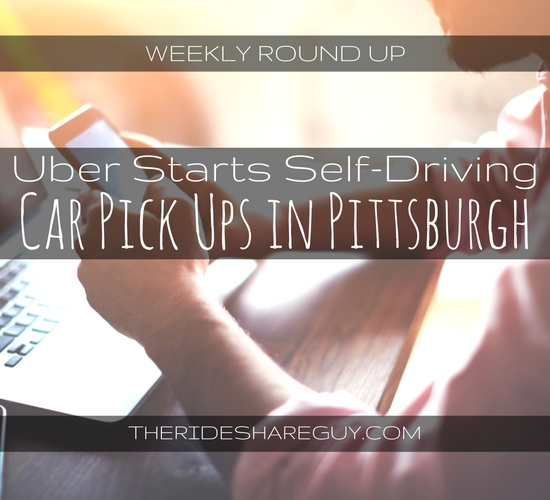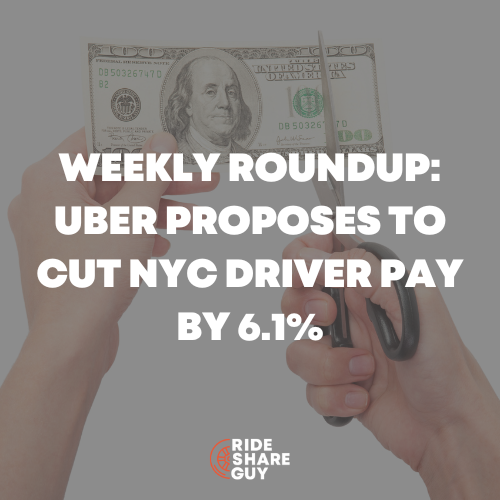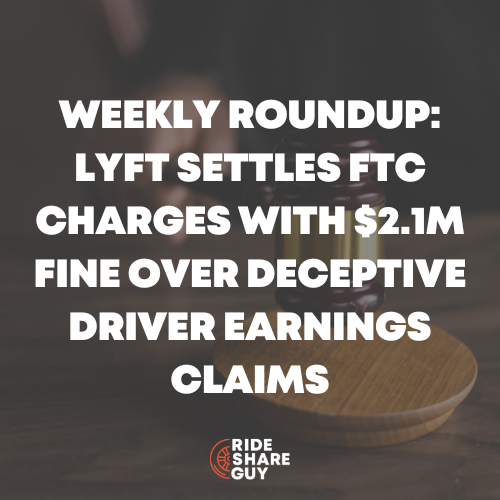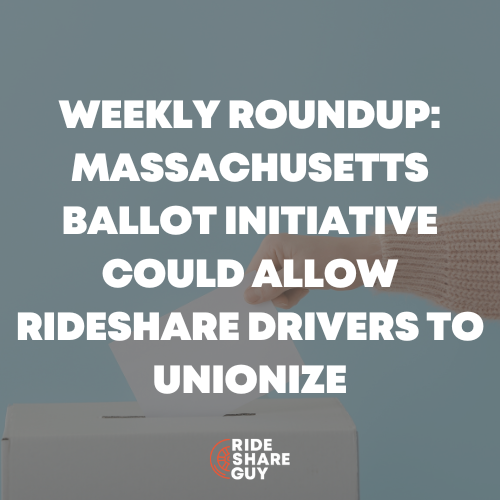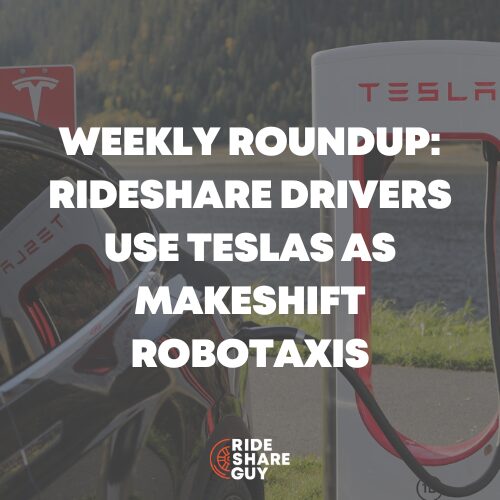Harry here. Lots of articles this week about self-driving cars upon the heels of Uber’s PR event in Pittsburgh. In case you missed it, I wrote an article yesterday that went in depth on all of the challenges Uber will face when it comes to self-driving cars.
Today RSG senior contributor John Ince shares his weekly rideshare roundup on what the media thought about Uber’s ‘self-driving cars’. Everything from what it’s like to ride around in one to what safety experts with no skin in the game are saying about the latest technology craze.
Uber starts self-driving car pickups in Pittsburgh [TechCrunch]
Beginning today, a select group of Pittsburgh Uber users will get a surprise the next time they request a pickup: the option to ride in a self driving car. The announcement comes a year-and-a-half after Uber hired dozens of researchers from Carnegie Mellon University’s robotics center to develop the technology. Uber gave a few members of the press a sneak peek Tuesday when a fleet of 14 Ford Fusions equipped with radar, cameras and other sensing equipment pulled up to Uber’s Advanced Technologies Campus (ATC) northeast of downtown Pittsburgh.
During my 45-minute ride across the city, it became clear that this is not a bid at launching the first fully formed autonomous cars. Instead, this is a research exercise. Uber wants to learn and refine how self driving cars act in the real world. That includes how the cars react to passengers — and how passengers react to them. “How do drivers in cars next to us react to us? How do passengers who get into the backseat who are experiencing our hardware and software fully experience it for the first time, and what does that really mean?” said Raffi Krikorian, director of Uber ATC. If they are anything like me, they will respond with fascination followed by boredom.
The experience… began when an Uber employee handed me a phone so I could hail a ride from the company’s app. A minute later, a Ford Fusion rolled up. Uber engineers occupied the two front seats, so I took a spot behind the driver. Once nestled into my seat, I selected a button on a tablet positioned in the back of the car to signal I was ready to go. The tablet displayed a live view of the car’s vision: blue for the road, red for objects. Our driving path took us from the ATC building in Pittsburgh’s Lawrenceville neighborhood through downtown and over the 9th Street bridge to the North Shore. The steering wheel turned on its own, as if possessed by a ghost. The engineer in the driver’s seat spent the entire ride watching the road. He hovered his hands over the wheel and foot over the pedal. Whenever a stopped vehicle blocked an entire lane, he toggled back into manual mode to switch lanes and drive around — an action Uber’s self driving cars will not yet take. The second engineer sat in the passenger’s seat with a laptop open. On a normal trip, he would have been taking notes about the ride.
I had a flurry of butterflies the first time the car encountered an obstacle — an SUV backing into the road. You don’t notice how many unexpected incidents occur during a routine drive until you ask a robot to take the wheel. …
My Take: Fascinating article where we get a sense of what it’s like to be in a semi-autonomous vehicle. Beyond the technology, a big question hovers over consumer acceptance. Yes, there will be the few first adopters – who will want to have an experience they can tell friends about, but mass acceptance is another matter entirely. Uber hasn’t done anything technologically amazing here, but what they’ve done with this is really remarkable. They’ve seized the spotlight in the driverless car race and taken control of the conversation about it, for the moment at least. But many questions remain about this technology.
The following articles give any clear thinking visionary at least a few good reasons to pause and consider.
Safety Experts Concerned Over Uber’s Self-Driving Taxi Test In Pittsburgh: Tech Not Ready For The Streets [Tech Times]
Sum and Substance: Uber revealed last month that it will be testing self-driving cars in the streets of Pittsburgh soon, with free rides to be offered to customers who would like to try riding in an autonomous vehicle.
The fleet of self-driving taxis is set to be released this week, but the move is concerning for safety experts who claim that the technology is not yet ready for such a widespread implementation. The experiment will be launched even with the fact that Pennsylvania has not passed basic laws that allow the testing of self-driving cars in the state, with no rules yet in place on what would happen in the case of an accident involving the vehicles. There is also no requirement for Uber to share the data that its vehicles will collect with regulators.
Researchers have also noted that self-driving cars have been confused by bridges, which is a big problem in Pittsburgh as it has more bridges compared with any other major city in the United States. In addition, vehicles cannot understand human gestures, such as an officer allowing children to cross the street, and the systems of the cars can be thrown off by devices such as GPS jammers.
“They are essentially making the commuters the guinea pigs,” said former National Highway Traffic Safety Administration head and consumer protection advocate Joan Claybrook. Claybrook warned that there will surely be crashes involved in the testing program, which she claimed can be done without having to involve citizens.
Will Uber’s testing program be successful, and launch a new age of self-driving vehicles being used for public transportation? Or are the concerns of safety experts true, with a host of accidents in Uber’s future? Only time will tell.
My Take: Uber’s approach to self driving cars mirrors their approach to almost everything else: barge right in and address questions later. Pittsburgh officials are just beginning to think through the implications of Uber’s self driving initiative – with special concern over the safety of passengers. When Google and others have tested self-driving cars, they have done it in very controlled environments. But in Pittsburgh, suddenly the technology will be tested in circumstances that defy predictability. (See New York Times article below) One thing is sure – if there is an accident or a fatality, it will be very big news and Uber’s PR staff will be scrambling to control the damage.
5 Things That Give Self-Driving Cars Headaches [NY Times]
Sum and Substance: Fully automated cars don’t drink and drive, fall asleep at the wheel, text, talk on the phone or put on makeup while driving. With their sensors and processors, they navigate roads without any of these human failings that can result in accidents. But there is something self-driving cars do not yet deal with very well – the unexpected. The human brain is still better than any computer at making decisions in the face of sudden, unforeseen events on the road – a child running into the street, a swerving cyclist or a fallen tree limb.
Here are five situations that, for now at least, often confound self-driving cars and the engineers working on them.
Unpredictable Humans: Autonomous vehicles will have to deal with drivers who speed, pass even when there’s a double yellow line and drive the wrong way on a one-way street.
Where Did the Lines on the Road Go? Snow, rain, fog and other types of weather make driving difficult for humans, and it’s no different for driverless cars, which stay in their lanes by using cameras that track lines on the pavement. But they can’t do that if the road has a coating of snow. Falling snow or rain can also make it difficult for laser sensors to identify obstacles. A large puddle caused by heavy rain may look like blacktop to an autonomous car’s sensors. In reports that Google and others have filed with California authorities about their on-road tests of autonomous cars, weather was a prime cause of system failures after which human drivers had to take back control.
Detours and Rerouted Roads: Google’s bubble-shaped self-driving cars rely heavily on highly detailed three-dimensional maps — far more detailed than those in Google Maps — that communicate the location of intersections, stop signs, on-ramps and buildings with the cars’ computer systems. Self-driving cars combine these maps with readings from their sensors to find their way around. Very few roads have been mapped to this degree. Moreover, maps can become out of date as road conditions change. There may be construction or detours. An intersection with a four-way stop might get a traffic light or become a roundabout.
It Might Be a Puddle. Or Not: Self-driving cars use radar, lasers and high-definition cameras to scan roads for obstacles, and the images they generate are assessed by high-powered processors to identify pedestrians, cyclists and other vehicles. But potholes are tough. They lie below the road surface, not above it. A dark patch in the road ahead could be a pothole. Or an oil spot. Or a puddle. Or even a filled-in pothole. I recently took a ride in a test vehicle with automated driving technology. It slowed unexpectedly at one point, momentarily confused by a dark area on the road ahead (it was a shadow caused by an overpass).
Having to Make Tough Decisions: In the midst of busy traffic, a ball bounces into the road, pursued by two running children. If a self-driving car’s only options are to hit the children or veer right and strike a telephone pole, potentially injuring or killing the car’s occupants, what does it do? Should its computer give priority to the pedestrians or the passengers?
My Take: Here’s the essence: drivers, especially in urban environments, are making countless split decisions often reacting to unpredictable situations. The human brain can process all this on the fly. But self-driving cars rely on programmers to try to anticipate everything that will happen in advance.
What happens when the programmers didn’t think of something? Would you like to be the passenger sitting in the car when that happens? I don’t think so. Beyond the technological challenge, Uber faces a huge marketing challenge in overcoming the natural and entirely rational fears of paying customers. I’m not saying they can’t do it, but I am saying it’s a huge challenge, and I don’t think they’ve got their head around it–yet. They may yet conquer that challenge too. Stranger things have happened – remember when we were all afraid to use ATMs because we didn’t trust a machine to accurately count our money every time?
Major job losses feared when self-driving cars take to the road [San Francisco Chronicle]
Sum and Substance: Millions of Americans make a living by driving trucks, delivery vans, taxis and ride-hailing cars. When technology takes the wheel, what will happen to their livelihoods? That question is growing more urgent as the advent of self-driving vehicles accelerates.
Major players like Ford, Volvo and Tesla Motors have introduced concrete plans. In Singapore, autonomous taxis are already on city streets, and Uber’s first fleet hits Pittsburgh this month. Predictions range from apocalyptic warnings of major unemployment and economic collapse to utopian views of new job categories, increased efficiency, and dramatic decreases in deaths and injuries from vehicle crashes.
Even Tesla CEO Elon Musk, whose company is pushing hard to develop autonomous vehicles, has warned that the technology could cost jobs. “If you have self-driving cars, then what happens to the 12 percent of the population whose job it is to drive a car or drive a truck?” Musk said at a forum in May. Self-driving vehicles, he said, are just one example of how artificial intelligence could create a “tremendous upheaval in terms of employment.”
Uber CEO Travis Kalanick has taken positions on both sides. He infuriated drivers two years ago by saying at a tech conference that getting rid of “the other dude in the car” through driverless technology would make Uber rides cheaper. But last month, he told Business Insider that human-piloted Ubers would still be needed and predicted that autonomous cars would spawn new jobs such as fleet maintenance. Initially, Uber’s Pittsburgh cars will carry an engineer ready to take the wheel if needed. Many ride-hailing drivers are dubious about their future but figure they will have time to devise a Plan B.
My Take: This is the uber issue hovering like a cloud over the industry that Uber dominates. Most drivers I’ve talked to see driverless cars so far off in the future that they’re not really concerned about any impact it will have over their immediate plans – which in many cases extends only until their next rent check is due.
Fully Autonomous Cars Are Unlikely, Says America’s Top Transportation Safety Official has [MIT Technology Review]
Sum and Substance: Christopher Hart, chairman of the National Transportation Safety Board, says his agency’s experience investigating accidents involving autopilot systems used in trains and planes suggests that humans can’t be fully removed from control. He told MIT Technology Review that future autos will be much safer, but that they will still need humans as copilots.
Autopilot systems can also create new dangers. The NTSB has said that pilots’ overreliance on automation has caused crashes. Do you worry about this phenomenon being a problem for cars, too?
The ideal scenario that I talked about, saving the tens of thousands of lives a year, assumes complete automation with no human engagement whatsoever. I’m not confident that we will ever reach that point. I don’t see the ideal of complete automation coming anytime soon. Some people just like to drive. Some people don’t trust the automation so they’re going to want to drive. [And] there’s no software designer in the world that’s ever going to be smart enough to anticipate all the potential circumstances this software is going to encounter. The dog that runs out into the street, the person who runs up the street, the bicyclist, the policeman or the construction worker. Or the bridge collapses in a flood. There is no way that you’re going to be able to design a system that can handle it. The challenge is when you have not-so-complete automation, with still significant human engagement—that’s when the complacency becomes an issue. That’s when lack of skills becomes the issue. So our challenge is: how do we handle what is probably going to be a long-term scenario of still some human engagement in this largely automated system …
My Take: This warning over unexpected situations and passenger safety is being voiced by one of the country’s top experts in this field. When the visions of dollar signs are dancing in the head of investors and entrepreneurs, it can cloud their thinking. I think that’s what’s happening here. Driverless cars for special applications in special situations – yes. Driverless cars replacing humans behind the steering wheel for any sizable segment of our population – no way!
Readers, what do you think of this week’s stories? Are self-driving cars the future, and are you concerned about them displacing human drivers?
-John @ RSG
Save
Save
